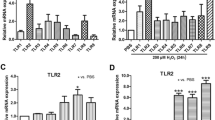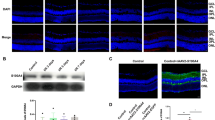Abstract
Purpose
There is increasing evidence that suggests stromal cell-derived factor-1 (SDF-1) can induce a protective response against ischemic injury in various organs. In this study, we examined the expression of SDF-1 in a rat model of retinal ischemia-reperfusion (IR) injury. Further, we explored the effect of estrogen 17β-estradiol (E2), and the role of estrogen receptor (ER) in regulating SDF-1 expression.
Methods
Retinal IR injury was established in Sprague–Dawley rats by elevating the intraocular pressure to 110 mmHg for 60 mins. Relative expression levels of SDF-1 mRNA and protein in the retina at 6 h, 12 h, and 24 h after reperfusion were determined by RT-PCR and western blot respectively. To investigate the influence of estrogen and ER on SDF-1 expression, E2 was administered intraperitoneally 30 mins before induction of ischemia, and the estrogen receptor antagonist ICI 182–780 was administered 1 h before E2 injection.
Results
SDF-1 expression in IR-injured retina is upregulated at 6 h, 12 h, and 24 h after injury, with maximum expression at 12 h. As expected, pretreatment of retinal IR rats with E2 enhanced the upregulation in SDF-1 expression after injury, through activation of the estrogen receptor. We proved this hypothesis by demonstrating that pretreatment of retinal IR rats with ICI 182–780 led to a partial decrease in E2-induced SDF-1 expression.
Conclusions
Our findings suggest that 17β-estradiol offers protection against retinal ischemic injury by inducing an upregulation in SDF-1 expression through activation of the estrogen receptor.




Similar content being viewed by others
References
Osborne NN (2010) Mitochondria: their role in ganglion cell death and survival in primary open angle glaucoma. Exp Eye Res 90:750–757
Rudkin AK, Lee AW, Aldrich E et al (2010) Clinical characteristics and outcome of current standard management of central retinal artery occlusion. Clin Exp Ophthalmol 38:496–501
Kim BJ, Braun TA, Wordinger RJ et al (2013) Progressive morphological changes and impaired retinal function associated with temporal regulation of gene expression after retinal ischemia/reperfusion injury in mice. Mol Neurodegener 8:21
Moreno A, Lozano M, Salinas P (2013) Diabetic retinopathy. Nutr Hosp 28(Suppl 2):53–56
Rey-Funes M, Dorfman VB, Ibarra ME et al (2013) Hypothermia prevents gliosis and angiogenesis development in an experimental model of ischemic proliferative retinopathy. Invest Ophthalmol Vis Sci 54(4):2836–2846
Zhu Y, Zhang Y, Ojwang BA et al (2007) Long-term tolerance to retinal ischemia by repetitive hypoxic preconditioning: role of HIF-1alpha and heme oxygenase-1. Invest Ophthalmol Vis Sci 48:1735–1743
Duh EJ, Yang HS, Suzuma I et al (2002) Pigment epithelium-derived factor suppresses ischemia-induced retinal neovascularization and VEGF-induced migration and growth. Invest Ophthalmol Vis Sci 43:821–829
Lai P, Li T, Yang J et al (2008) Upregulation of stromal cell-derived factor 1 (SDF-1) expression in microvasculature endothelial cells in retinal ischemia-reperfusion injury. Graefes Arch Clin Exp Ophthalmol 246:1707–1713
Yellowley C (2013) CXCL12/CXCR4 signaling and other recruitment and homing pathways in fracture repair. Bonekey Rep 2:300
Huang C, Gu H, Zhang W, Manukyan MC et al (2011) SDF-1/CXCR4 mediates acute protection of cardiac function through myocardial STAT3 signaling following global ischemia/reperfusion injury. Am J Physiol Heart Circ Physiol 301:H1496–H1505
Huang C, Gu H, Wang Y et al (2011) Estrogen-induced SDF-1 production is mediated by estrogen receptor-α in female hearts after acute ischemia and reperfusion. Surgery 150:197–203
Stokman G, Stroo I, Claessen N et al (2010) SDF-1 provides morphological and functional protection against renal ischaemia/reperfusion injury. Nephrol Dial Transplant 25:3852–3859
Butler JM, Guthrie SM, Koc M et al (2010) SDF-1 is both necessary and sufficient to promote proliferative retinopathy. J Clin Invest 115:86–93
Wang YQ, Zhang XM, Wang XD et al (2010) 17-AAG, a Hsp90 inhibitor, attenuates the hypoxia-induced expression of SDF-1alpha and ILK in mouse RPE cells. Mol Biol Rep 37:1203–1209
Finucane FF, Madans JH, Bush TL et al (1993) Decreased risk of stroke among postmenopausal hormone users: results from a national cohort. Arch Intern Med 153:73–79
Barrett-Connor E, Bush TL (1991) Estrogen and coronary heart disease in women. JAMA 265:1861–1867
Dilsiz N, Sahaboglu A, Yildiz MZ et al (2006) Protective effects of various antioxidants during ischemia-reperfusion in the rat retina. Graefes Arch Clin Exp Ophthalmol 244:627–633
Jung SH, Kim KA, Sohn SW et al (2014) Association of aqueous humor cytokines with the development of retinal ischemia and recurrent macular edema in retinal vein occlusion. Invest Ophthalmol Vis Sci 55(4):2290–2296
Aiuti A, Webb IJ, Bleul C et al (1997) The chemokine SDF-1 is a chemoattractant for human CD34+ hematopoietic progenitor cells and provides a new mechanism to explain the mobilization of CD34+ progenitors to peripheral blood. J Exp Med 185:111–120
Hu X, Dai S, Wu WJ et al (2007) Stromal cell derived factor-1 alpha confers protection against myocardial ischemia/reperfusion injury: role of the cardiac stromal cell derived factor-1 alpha CXCR4 axis. Circulation 116:54–63
Tögel F, Isaac J, Hu Z et al (2005) Renal SDF-1 signals mobilization and homing of CXCR4-positive cells to the kidney after ischemic injury. Kidney Int 67:1772–1784
Bucolo C, Drago F (2004) Effects of neurosteroids on ischemia-reperfusion injury in the rat retina: role of sigma1 recognition sites. Eur J Pharmacol 498:111–114
Cong B, Zhu X, Cao B et al (2013) Estrogens protect myocardium against ischemia/reperfusion insult by up-regulation of CRH receptor type 2 in female rats. Int J Cardiol 168:4755–4760
Russo R, Cavaliere F, Watanabe C et al (2008) 17Beta-estradiol prevents retinal ganglion cell loss induced by acute rise of intraocular pressure in rat. Prog Brain Res 173:583–590
Nonaka A, Kiryu J, Tsujikawa A et al (2000) Administration of 17beta-estradiol attenuates retinal ischemia-reperfusion injury in rats. Invest Ophthalmol Vis Sci 41:2689–2696
Yu X, Tang Y, Li F et al (2005) Protection against hydrogen peroxide-induced cell death in cultured human retinal pigment epithelial cells by 17beta-estradiol: a differential gene expression profile. Mech Ageing Dev 126:1135–1145
Rae JM, Johnson MD, Scheys JO et al (2005) GREB 1 is a critical regulator of hormone dependent breast cancer growth. Breast Cancer Res Treat 92:141–149
Sauvé K, Lepage J, Sanchez M et al (2009) Positive feedback activation of estrogen receptors by the CXCL12-CXCR4 pathway. Cancer Res 69:5793–5800
Glace L, Grygielko ET, Boyle R et al (2009) Estrogen-induced stromal cell-derived factor-1 (SDF-1/Cxcl12) expression is repressed by progesterone and by selective estrogen receptor modulators via estrogen receptor alpha in rat uterine cells and tissues. Steroids 74:1015–1024
Hall JM, Korach KS (2003) Stromal cell-derived factor 1, a novel target of estrogen receptor action, mediates the mitogenic effects of estradiol in ovarian and breast cancer cells. Mol Endocrinol 17:792–803
Hall JM, Korach KS (2013) Endocrine disrupting chemicals promote the growth of ovarian cancer cells via the ER-CXCL12-CXCR4 signaling axis. Mol Carcinog 52:715–725
Vornehm ND, Wang M, Abarbanell A et al (2009) Acute postischemic treatment with estrogen receptor-alpha agonist or estrogen receptor-beta agonist improves myocardial recovery. Surgery 146:145–154
Favre J, Gao J, Henry JP et al (2010) Endothelial estrogen receptor {alpha} plays an essential role in the coronary and myocardial protective effects of estradiol in ischemia/reperfusion. Arterioscler Thromb Vasc Biol 30:2562–2567
Chen Y, Jin X, Zeng Z et al (2009) Estrogen-replacement therapy promotes angiogenesis after acute myocardial infarction by enhancing SDF-1 and estrogen receptor expression. Microvasc Res 77:71–77
Parvathaneni K, Grigsby JG, Betts BS et al (2013) Estrogen-induced retinal endothelial cell proliferation: possible involvement of pigment epithelium-derived factor and phosphoinositide 3-kinase/mitogen-activated protein kinase pathways. J Ocul Pharmacol Ther 29:27–32
Mokhonov VV, Theendakara VP, Gribanova YE et al (2012) Sequence-specific binding of recombinant Zbed4 to DNA: insights into Zbed4 participation in gene transcription and its association with other proteins. PLoS One 7:e35317
Acknowledgments
This work was supported by Foundation of Heilongjiang Educational Department (NO. 12531389).
All authors have read and approved the content, and agree to submit for consideration for publication in the journal. There are no any ethical/legal conflicts involved in the article.
Author information
Authors and Affiliations
Corresponding author
Rights and permissions
About this article
Cite this article
Wang, Y., Li, X., Wang, J. et al. 17β-estradiol mediates upregulation of stromal cell-derived factor-1 in the retina through activation of estrogen receptor in an ischemia-reperfusion injury model. Graefes Arch Clin Exp Ophthalmol 253, 17–23 (2015). https://doi.org/10.1007/s00417-014-2657-8
Received:
Revised:
Accepted:
Published:
Issue Date:
DOI: https://doi.org/10.1007/s00417-014-2657-8




